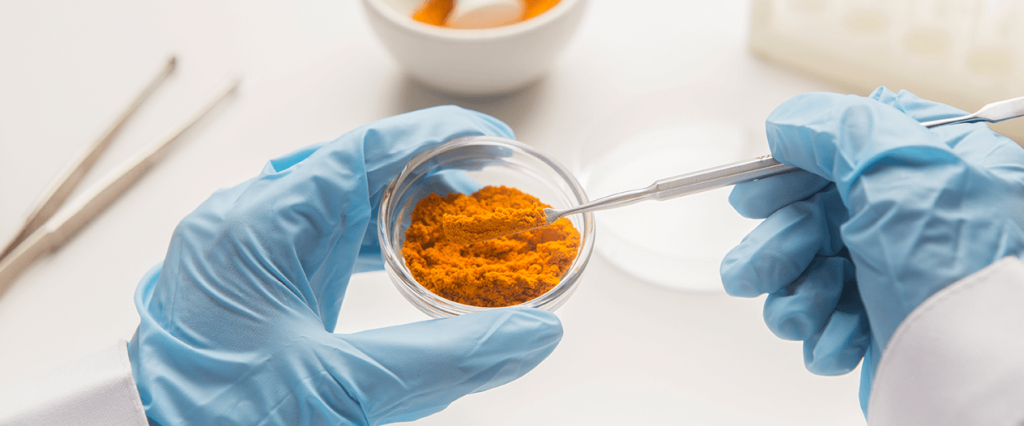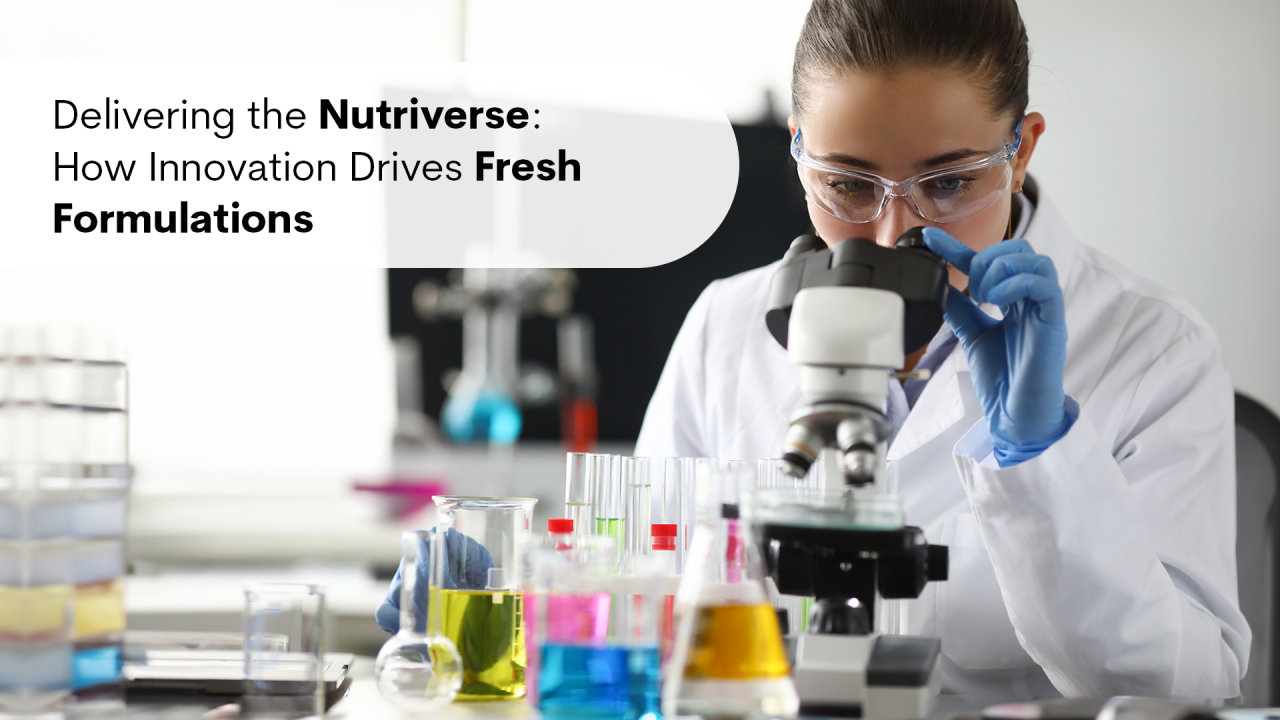Turmeric has received worldwide attention for multiple health benefits over the years. Curcuminoids (Curcumin) the active compounds from Turmeric are responsible for its therapeutic action. While the therapeutic benefits of turmeric are supported by numerous clinical trials and publications, its usage is limited by the high daily dosage requirements. This high daily dosage is required to overcome the constraints of turmeric. Issues that greatly limit the effectiveness and usefulness of turmeric are its low absorption of curcumin and poor bioavailability, water insolubility, and rapid metabolism of inactive metabolites. Turmeric is an oil/fat-soluble compound, practically insoluble at room temperature in water at acidic and neutral pH. Therefore, various techniques/processes have been developed to enhance solubility or dispersibility to enhance bioavailability and consequent bio-efficacy.
A variety of delivery systems have been utilized for turmeric-based ingredients including, micelles, liposomes, phospholipid complexes, microemulsions, nano-emulsions, emulsions, solid lipid nanoparticles, nanostructured lipid carriers, biopolymer nanoparticles, and microgels, all of which are aimed at improving the bioavailability.
Many turmeric extract manufacturers have utilized various techniques to decrease particle size as the incorporation of curcumin in liquid droplet nano-micelles containing lauroyl polyoxy 32-glycerides and polysorbate 20; fenugreek-derived galactomannan fiber liquid droplets and caprylocaproyl polyoxyglycerides ; colloidal dispersions using ghatti gum and glycerin; a matrix of glycerol esters of fatty acids, medium-chain triglycerides, hydroxymethylcellulose and sodium alginate, a proprietary mixture of surfactants, polar lipids and solvents, solid lipid curcumin particles composed of docosahexaenoic acid (DHA), soy lecithin, stearic acid, and vitamin C esters, blend of sodium caseinate and Tween 20; proprietary microcapsules and a complex with acacia gum, quillaia (high in saponins) and sunflower oil. These techniques also involve the use of ingredients as polysorbate 80, ceramic particles, polyethylene glycol (PEG), alginate, poly (lactic-co-glycolic acid) (PLGA), and other substances.
Most of these turmeric extract manufacturers are using synthetic ingredients for improving dissolution, claims improved bioavailability. Clinical substantiation is shown through dose-normalized calculations in the pharmacokinetic (PK) study. Thus, the PK studies are conducted on different doses of test and reference and a mathematical extrapolation is done to arrive at the factor of improved bioavailability or absorption. This is then claimed by the ingredient as “X” times more bioavailable.
While this is extremely valid from an academic and research standpoint but the first step in affecting a dose reduction for turmeric extract and needs to be further supported by full clinical efficacy trials to showcase efficacy at the reduced dose. Moreover, these formulations fail to take into consideration is the solubility-permeability interplay in the gastrointestinal tract. A solubility-enhancing formulation may result in a decrease in permeability, remain unchanged or even increase permeability. Therefore, a solubility-enhancing formula may not improve overall absorption. Claims of enhanced bioavailability cannot be made solely because of increased solubility and need a complete clinical substantiation with dose co-relation between the doses used in the PK study and the efficacy study.
Detailed study analysis of the clinical substantiation trials of these turmeric extracts shows that there is rarely dose co-relation between the PK study and the efficacy study. Interestingly, while the turmeric extracts and the formulation using the synthetic ingredients make aggressive claims on improved bioavailability, it is found that the dose recommendations are inconsistent with these claims. This means that the end consumer at the end receives no benefit in terms of a reduced dose despite having an expectation of “X” times of improved bioavailability of curcumin from turmeric supplements as per product label claims.
Furthermore, it is also important to consider the nature and the source of these solubility improving excipients. While a lot of enhanced turmeric extract claim the use of excipients that are generally recognized as safe (GRAS), it is pertinent to note that GRAS status is dependent on the volume quantity and purpose of usage, i.e., the excipients certified as GRAS for usage quantity up to 5% in a formulation cannot be used at higher percentages. [1]
The next step would be to consider the nature of these excipients, which are synthetic chemicals used in natural turmeric extract to increase solubility and absorption.
For example, Tween 80 A.K.A. Polysorbate 80 is a hydrophilic nonionic surfactant. It is utilized as a surfactant in soaps and cosmetics, and it has permitted application in a food product but polysorbate 80 has been implicated in several systemic adverse reactions (e.g., hypersensitivity, nonallergic anaphylaxis, rash) and injection- and infusion-site adverse events (ISAEs, e.g., pain, erythema, thrombophlebitis). Polysorbate 80 has also been implicated in cases of renal and liver toxicity. [2]
Chemical such as γ-Cyclodextrin is also used to increase the bioavailability of active ingredients, but cyclodextrins are currently not included in the European Commission Guideline on excipients in the label and package leaflet of medicinal products for human use. [3]
Another excipient commonly used is soy lecithin is derived from highly processed soy oil. Most allergists recommend that patients with soy allergy need to avoid soy lecithin. Phosphatidylcholine which is another excipient used to increase the bioavailability of curcumin is sourced from soy lethicin.
These excipients are permitted for usage in pharmaceutical formulations and their safety has been established at the sanctioned level of usage. In most cases, these permissions are provided since the benefit of inclusion into a pharmaceutical product greatly outweighs the risks since these pharmaceutical products are normally used for a limited period (for a fixed-dose regimen of a few days and constantly monitored in longer-term usage). Thus, synthetic excipients may have either adverse impact on the health of consumers considering the longer-term and non-monitored usage of supplements. If the use of such synthetic ladened turmeric supplements continued for a substantial period or with allergens can create unwanted health complications among consumers who already have some allergy history.
As the consumer nutrition brand, the dietary turmeric supplement manufacturers are in direct contact with the end consumer, and most consumer experiences and expectations are directly correlated with the finished product. It is of utmost importance that dietary supplement & nutrition product brands and manufacturers take all the above-discussed factors into the account while selecting the turmeric extract for their products specially to maintain the expectation of a natural, plant-based clean label product.
At Nutriventia, our philosophy has always been to put the benefit of our customers and their consumers first therefore we have created turmeric extract-based ingredient TurmXTRA®60N with 60% curcuminoids (the highest) in a water-dispersible format, without any synthetic excipients, clinically substantiated through a complete clinical package for a dose as low as 250mg.
A standard turmeric extract typically contains 95% curcumin concentration. Most dietary supplement manufacturers using 95% standard turmeric extract, recommend multiple capsules dosage to achieve the intended therapeutic effect. With proven bioequivalence and high potency formulation,
TurmXTRA®60N is expected to be equally effective at 1/10th the dose of 95% standard turmeric extract. Moreover, it does not contain any synthetic excipients, it has the only diet sourced excipients making it more suitable for long-term use and it preserves the very essence of turmeric being natural [4].
It addresses consumer’s needs and requirements without compromising on quality or the philosophy of putting the customer’s need first. To know more about TurmXTRA®60N and its clinical study package, get in touch with us.
Reference:
[1] https://www.ncbi.nlm.nih.gov/pmc/articles/PMC7144558/
[2] https://www.ncbi.nlm.nih.gov/pmc/articles/PMC6015121/#CR40
[4] https://academic.oup.com/jpp/article-abstract/73/6/816/6181831



